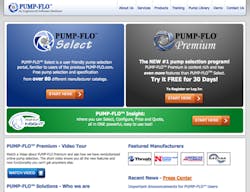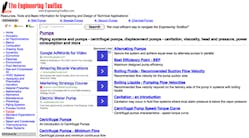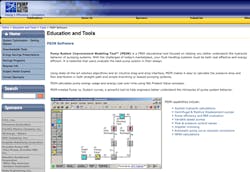Having worked in a digital world for 15-plus years, one of the things I take for granted is just how much information is readily available to me with just a few rat-a-tat-tats on the ‘ole keyboard. At the same time, I often find myself bombarded with so much information via email and social media and what the search engines spit out, that it’s easy to get led astray. With this sentiment in mind, below is a digest that aims to streamline the search for helpful online tools for engineers, operators, and mechanics involved with industrial pumping systems.
If you have suggestions for fluid handling-related online tools that you think are worthy of highlighting on the FlowStream blog, send them to me at [email protected]. I will be writing more digest blogs of this sort going forward, and your tips and insights are always welcome.
READ ALSO: 6 Online Resources for Sealing Systems That You Need to Know About
1. PUMP-FLO.com
PUMP-FLO.com is a service designed to help pump buyers, sellers, and educators to size, select and configure centrifugal pumps from leading manufacturers’ catalogs. PUMP-FLO.com features select pumps from 103 different pump manufacturers. The program, which has 300,000 registered users, also has the ability to calculate the Total Head and NPSHa for pump selection based on the piping system the pump is installed into. With the system information, the program can perform an annual cost calculation for both fixed and variable-speed pump operation.
The PUMP-FLO.com site is free to all registered users, and registration is free as well.
A paid subscription program, called PUMP-FLO Premium, provides more system calculation tools that allow for selection from multiple pump manufacturer catalogs.
>> Check out this Online Tool for Pumping Systems here.
2. Engineering Toolbox: Pumps
>> Check out this Online Tool for Pumping Systems here.
3. Pump System Improvement Modeling Tool™ (PSIM)
PSIM includes:
- System hydraulic calculations
- Centrifugal- & positive-displacement pumps
- Pump efficiency and BEP evaluation
- Variable-speed pumps
- Flow & pressure control values
- Impeller trimming
- Automatic pump curve viscosity corrections
- NPSH calculations
>> Check out this Online Tool for Pumping Systems here.
4. ADEPT Pump Selection Tool for HVAC Systems
Armstrong Fluid Technologies recently launched a new online platform, called ADEPT, for selecting pumps for HVAC systems. The free tool is based on Armstrong’s Design Envelope concept, which aims to present a pre-set arrangement of the most efficient pump selections for a given capacity range. The Design Envelope approach to system selection is designed to reduce design risk and avoid costs stemming from equipment change orders by calculating preliminary performance requirements, then selecting a Design Envelope that offers sufficient comfort zone around the design-day operating point. Most importantly, according to Armstrong, the Design Envelope approach uses the users operating profile to align the range of best operating efficiency with the most frequently occurring operating speeds. For more information, watch the video below.
/ext/resources/blog_flowstream/2014/0414/FCBlog-0414-Grundfos_FEAT.png
Matt Migliore is the director of content for Flow Control magazine and FlowControlNetwork.com. He can be reached at [email protected].





